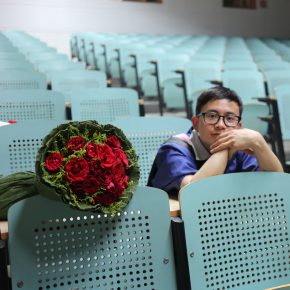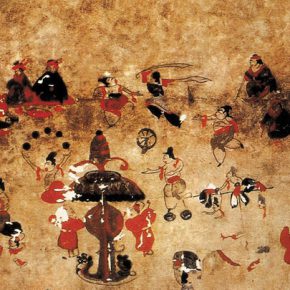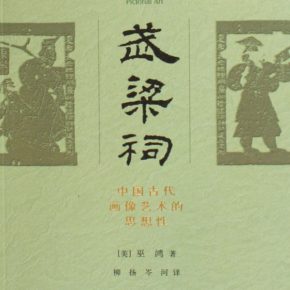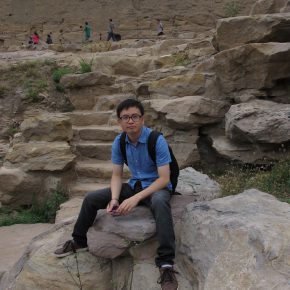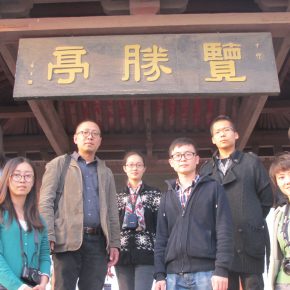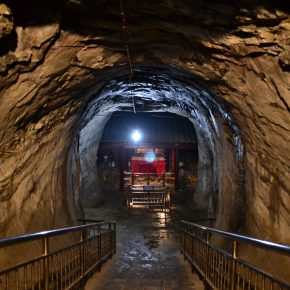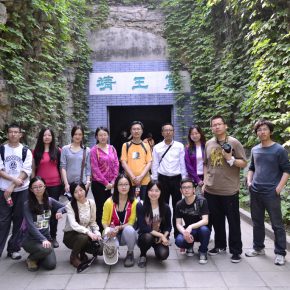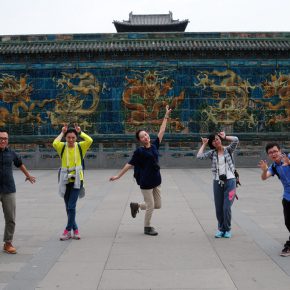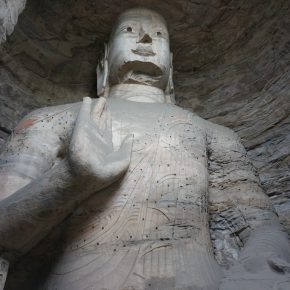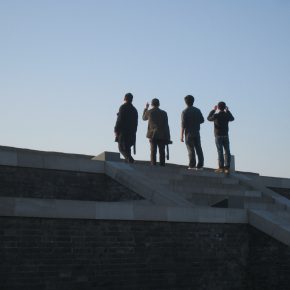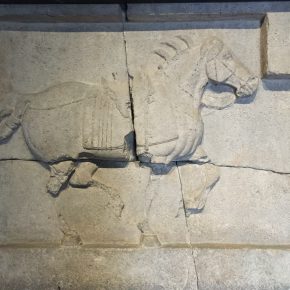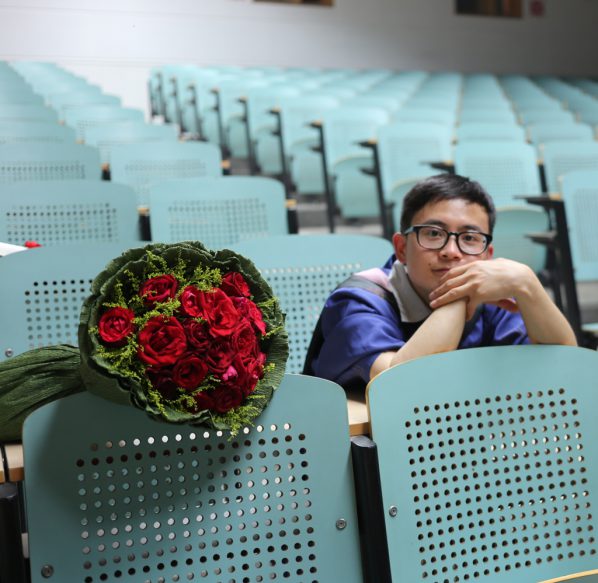
Since I have some friends from the “Ancient Tomb School”, I was fortunate to meet Dr. Tang Yu at a dinner party. The first impression he gave me was that he was introverted, not talkative and cute, which is a typical feature of the School of Humanities. Later we often met in our campus and then gradually got to know each other well.
Tang Yu came from Yingkou, Liaoning Province, and he was a typical liberal arts student in high school, while he also liked art, and studied painting for a while, he never considered painting as a stepping stone to the university entrance exam, on the one hand the traditional ordinary family believed that it was important for a student to be admitted to a multiversity, on the other hand, Tang Yu didn’t have any confidence in participating in the entrance exam of the plastic arts, and painting was just his hobby in middle school. However, he knew CAFA (Central Academy of Fine Arts) was the best academy of fine arts in China when he communicated with the teachers and students, since then his literature and art cells were awakened and a “CAFA complex” emerged.
Later, Tang Yu was successfully admitted to the Minzhu University of China, majored in historiography, which is a good choice for a liberal arts student. When he was a freshman and sophomore, he learned general Chinese and Western history, which is similar to Chinese and Western art history that is part of the undergraduate course of the School of Humanities, CAFA, and he also needed to take an “Introduction to Archaeology” course and the other professional disciplines related to history. In a junior professional writing course, he learned under the archeologist Prof. Yang Nan to write an article on“Summary of Xinglongwa Cultural Studies”, which was probably the first time for him to formally enter the field of archeology, the accumulation of literature and art cells meant that he did not consider it a boring course, and found his enjoyment and later, he finished the “Studies of Helingeer Han Tomb Murals” under the guidance of Prof. Li Hongbin. Seen from his interests at that time, it is the same with the research vision of the School of Humanities. Tang Yu also recalled that one of his senior fellow apprentices recommend to him a set of “Open ArtHistory Books”, which has greatly inspired him, especially the book “Wuliang Temple” by Wu Hong.
When he was a sophomore, he once again switched his attention to CAFA, and hoped to realize his CAFA dream with the postgraduate entrance exam. For a long time he had to get up at about 6:00 am to go to Huajiadi from Weigongcun by bus in order to attend the courses, and he heard the courses by He Xilin, Zheng Yan, Shao Yiyang, Yuan Xiaojin, and so on. The freshman and sophomore of the School of Humanities basically learn Chinese and Western art history, introduction to art and other professional courses, the art history has a close relationship with visual images, and also has a strong narrative, so students often do not feel bored, but the introduction to art and other related theoretical courses demand a stronger abstract theoretical thinking, and are inextricably associated with philosophy, aesthetics, sociology, anthropology and other disciplines, which is far from what students learn in high school, so students usually feel it difficult at the beginning. The combination of history and theory is the most important feature of the School of Humanities, along with the continuous accumulation and mental training, the clear understanding of the developing law of the whole arthistory will be gradually established. Recalling that experience, Tang Yu said it was really hard and he often slept on the bus, but he has persisted for several years because of his dream. The classroom of the School of Humanities is as big as a lecture, in addition to the students of the School of Humanities, there are many advanced students as well as outside students that come to attend, and CAFA has been open and inclusive.
Compared to Minzhu University of China, CAFA is a small school, which is not only small in size but also has a small number of students, and part of the teaching facilities are also relatively small, Tang Yu was not suited to it, and he feels deeply that the library is too small, but it has collected relatively rich and comprehensive professional books. Tang Yu has developed a habit of buying his own books in CAFA, and now the dormitory is piled with a lot of books, so it is the biggest burden to move after graduation. In addition, Tang Yu finds CAFA’s students have an unique “high cold” temperament, seeming to be immersed in their own little worlds, the discipline of humanities is thoughtful, introverted, subtle and perhaps also bookish.
The graduate tutor and doctoral tutor of Tang Yu is Prof. He Xilin, and his research directions are both the visual culture of Han and Tang Dynasties, which is a study of archeological art direction, focusing on the early and medium Chinese artistic development forms, and mainly researches tomb murals, tombs culture, etc., because they often deal with burials, people call them “Ancient Tomb School”. When he was a first year graduate student, he was lucky that he had the opportunity to attend the courses of Qiu Zhenzhong, Liu Tao and Jiang Feide, who rarely open a professional course. During the study period, he participated in the discussion courses organized by his tutor, and Prof. Zheng Yan, to gradually accumulate and form his own knowledge system in the process of study and discussion.
Reading, walking, visiting outside are indispensable compulsory subjects of the archaeological art, during the study, the teacher He Xilin has organized a team to visit the museums, archaeological sites and temple murals in the Shijiazhuang area, and Tianshui Maiji Mountain Grottoes, because He Xilin is from Xi’an, the observation of Shaanxi area is the most informative. In addition, Tang Yu also travelled to new places during his vacation, including Dunhuang Mogao Grottoes, Datong Yungang Grottoes, Wutai Mountain, Yongle Palace, etc., so as to have an immersive experience of ancient art forms and color, and also maintaining image materials for future research. Recalling the experiences, Tang Yu felt that it was cost effective to follow the teacher to observe and visit places, the teacher has always sorted and explained it, but he would be inevitably slack when he independently visited and his teacher could always mobilize more social resources, and they could see some things that are hard to see, in addition, he always knew how to save money in tickets, transport, accommodation, etc., also how to assist the lives of students.
For the art archeology, Tang Yu said it was different from the general archeology and academy students rarely studied or personally visited an archaeological excavation site, he just visited some burial sites, and the Mancheng Han Tomb, which was an important archaeological excavation site in the 1960s, this was the first burial site he visited, it has been developed as an attraction, but the burial form is substantially preserved, he was excited to enter a tomb for the first time, and understood many things when he had an immersive experience in the burial process rather than learning it from the perspective of literature. In Tang Yu’s opinion, the art archeology still belongs to the category of art history, which is able to cross-blend several disciplines, so that it is necessary to continue to study literature, archeology, anthropology, historiography, etc., which is aprocess of continuous accumulation of knowledge, it was still hazy when he was a postgraduate, who constantly researched and wrote to grasp an understanding of the basic materials and research and gradually became involved in the doctoral research. For the academic research, Tang Yu believed that the specific view and the macro architecture should strive to innovate, while keeping the “disciplines” of art history, it diverges the individual thinking as much as possible, expanding their own horizon.
Tang Yu’s understandings of academic research is basically condensed in the doctoral thesis “Studies on Six Steeds of Zhao Mausoleum”, in a discussion class, when Prof. He Xilin led the students to read Chen Yinque’s “On the Origin of the Sui and Tang System as Issued”, he keenly captured the thing that was worthy of further exploration in the Sui and Tang dynasties connecting the past and the future. Inspired by his tutor Prof. He Xilin, Tang Yu took this issue as the topic of his doctoral thesis, but he was often trapped in the previous researchers’ thinking on specific writing. How to start, how to develop, where it will lead to, it is a work challenging his mental and physical energy. He once focused on the era changes of burial murals in the Sui and Tang Dynasties, the role of Yan Liben and the Yan’s family in the art field, Emperor Taizong of Tang shaped the ideal of home and country reflected on the construction process of Zhao Mausoleum, etc., but he still could not successfully enter the state of writing. Finally, under the coaching of Prof. Zheng Yan from the School of Humanities, he made an adjustment and started on “Studies on Six Steeds of Zhao Mausoleum” which started with the ontology research, creating an in-depth discussion, and striving to have a breakthrough in the methodology.
Tang Yu passed the oral defense of his Ph.D. in May, so he is relaxed now, and waiting for a job. Graduates of the School of Humanities have many employment opportunities, covering art institutions, art museums, galleries, media, auction houses, publishers, and they basically become the art observers, writers and operators for the whole art ecology when they start work. When Tang Yu presents his resume to apply for a job, he can obviously feel CAFA’s profound influence in academic circles, and many employers pay attention to CAFA’s graduate resumes and the recommendation by CAFA’s professor.
It is very smooth to finish the 6 years of postgraduate and doctoral study, recalling the learning process of CAFA, Tang Yu feels that although “an apprentice’s skill is self-made”, the direction of approach and pattern by a tutor is very important, Prof. He Xilin is a very responsible teacher, Tang Yu stated that, he would like to correct their articles with four color pens, to separate his modifications into 4 parts including deleting, adding, questioning and commenting, which makes many students envious. The disciplines of the School of Humanities are basically in need of standing on an indifferent post, which is an edification of the teachers who have a personal experience with the students, and Tang Yu often finds Zheng Yan and other teachers still reading and writing at the office after 23:00. Now Tang Yu has graduated with a doctoral degree after being in a different post for 7 years, and he hopes to take this as a starting point to bear fruit on his own academic study as early as possible.
Image courtesy of Tang Yu
Text by Zhang Wenzhi, translated by Chen Peihua and edited by Sue/CAFA ART INFO


